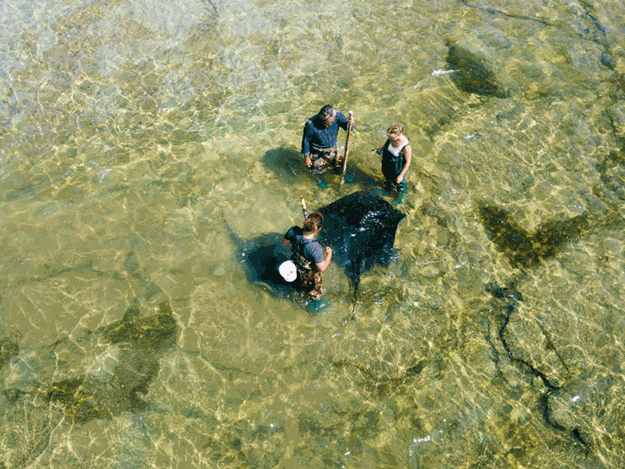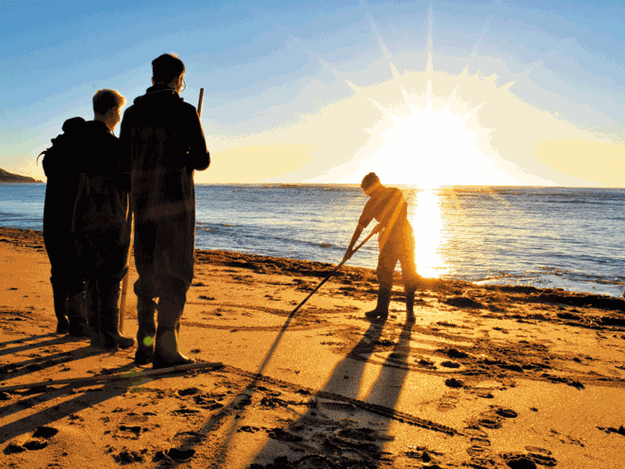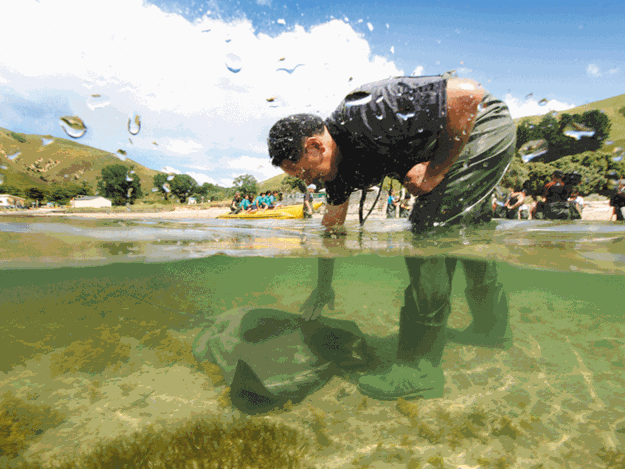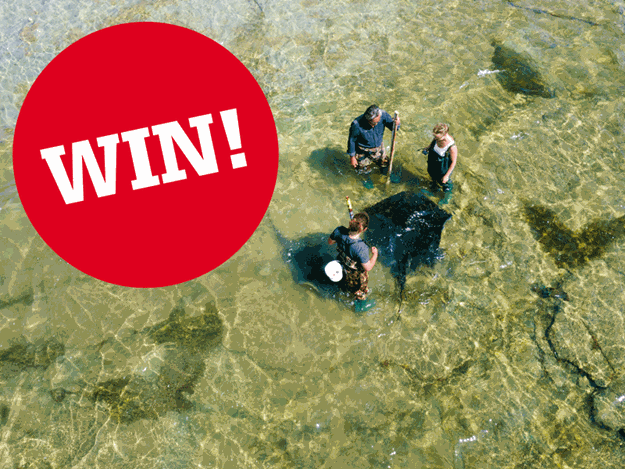It was 42 degrees Celsius on the Kimberley Coast of north-western Australia – too hot to be in the caravan and too hot to sit outside. In the hammering heat, the polished sea, sliding gently across treacle-coloured rocks, was irresistible. But it was alive with life-limiting critters.
 |
|
Short-tailed stingrays can be huge |
None-the-less I dipped my scorching torso into the shallows, watching nervously for stingers snakes and sharks. Immediately, 5m in front of me, two large menacing triangles of black came gliding through the water – not one shark but two. Never has a body left the water so fast.
Squeaking in fear, I flung myself at the shore. And then, as I stood agape and panting, the fins waved at me. This was my first close encounter with a stingray. An enormous creature – about 3m across – it cruised the surf as friendly as a domestic pet.
Fast-forward several years and my next meeting with stingrays was when I literally bumped into some of them on the east coast of New Zealand, just north of Gisborne. Tatapouri Bay, surrounded by rippled hills, is different in character to the usual sandy beaches of the coast.
 |
|
Instructions at sunrise. Reef expeditions are tide-dependent |
Rocky ribs protrude into the sea to form a shallow lagoon and the most exciting thing in the bay is that, at low tide, people can venture out onto the reef to visit the eagle rays and enormous short-tail stingrays that hang about the edge of the rocks.
On the shore is a small rustic centre built of timber from which Chris and Dean Savage run Dive Tatapouri. Among various other marine activities, they guide visitors out onto the reef at low tide for close encounters with these gentle sea creatures.
A small group of us donned seaweed-green waders and, armed with long poles to help us, waded gingerly across the rocks. At the designated point, we lined up to form a ‘picket fence’, and each of us was given one piece of barracuda. We waited.
Dean, who has been involved with the sea all his life, was our guide. Often referred to as Stingray Dundee, he wears an Akubra banded with shark teeth to add to the image. Dean told us what to expect and how to behave. He also taught us how not to get on the wrong side of the rays.
We paid close attention. None of us wanted to feel the sting of a tail. It wasn’t long before an eagle ray and several short-tailed stingrays came ghosting through the shallows. A large short-tail homed in on me to suck up my offered morsel between her soft lips and then nudge against my leg looking for more.
I was bewitched. There’s an aura of mystery around these sea creatures as they slide through the water with elegant undulating motions of their broad front fins. They were foreign, but I felt no fear.
“Rays belong to the same family as sharks, and share some of the same features,” says Dean, who has a tonne of knowledge and is a great storyteller. “They have skeletons of cartilage, not bone. But rays differ from sharks in that their teeth are blunt rather than sharp.”
 |
|
Rays don't seem to mind being stroked |
The reef at Tatapouri is a breeding ground and all the rays were female. I was gently stroking the smooth back of an eagle ray, when near my feet there was a watery rumpus and a flash of silver and yellow. The young Highland lass to my left reeled in her boots. “The fooker bit me,” she shrieked. It was a wild reaction.
The “fooker” was, in fact, a kingfish that had swooped on her fish bit and scuffed her finger. “They do have nippy little teeth,” Chris told me later, “and might lightly graze the skin but it’s not much to worry about. And we like people to understand that we are visiting wild creatures in their habitat.
They interact with us but don’t rely on us. We don’t attempt to tame them, so we only feed the stingrays a token amount to keep them interested. The kingies pinch a bit when they can.”
My short-tailed ray had taken no chances and hoovered up the lot. She glided away from me to mingle with the others for a bit and then came back to feel up my boot. I was flattered and intrigued. I rather thought we’d bonded over that bit of barracuda. It’s unlikely my feelings were reciprocated.
The Te Ika Māui myth indicates that Māui’s fish (i.e. the North Island) was a stingray. There are numerous other Māori legends that mention stingrays. If you want to encounter these magical sea creatures at Dive Tatapouri, best make a booking as times vary according to tides (divetatapouri.com).
Visitors can be ferried to the reef in a banana boat if walking over rocks does not appeal. If there is an early morning start, the Tatapouri Motor Camp (tatapouri.co.nz) is just up the road.
Stingray experience for two competition

Be in to win a Stingray Experience for two with Dive Tatapouri.
Click here to enter before 20 September 2019.  Be in to win a Stingray Experience for two with Dive Tatapouri.
Click here to enter before 20 September 2019.
Be in to win a Stingray Experience for two with Dive Tatapouri.
Click here to enter before 20 September 2019. 


 Be in to win a Stingray Experience for two with Dive Tatapouri.
Click here to enter before 20 September 2019.
Be in to win a Stingray Experience for two with Dive Tatapouri.
Click here to enter before 20 September 2019. 




